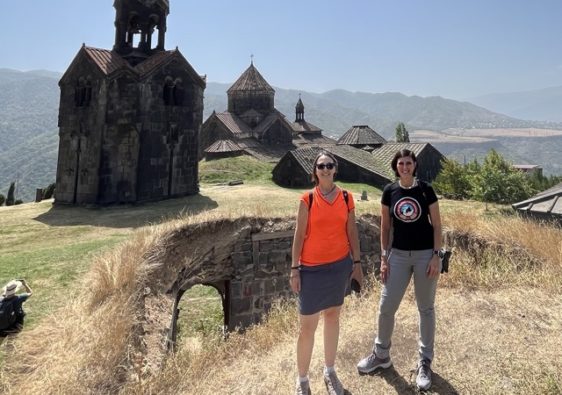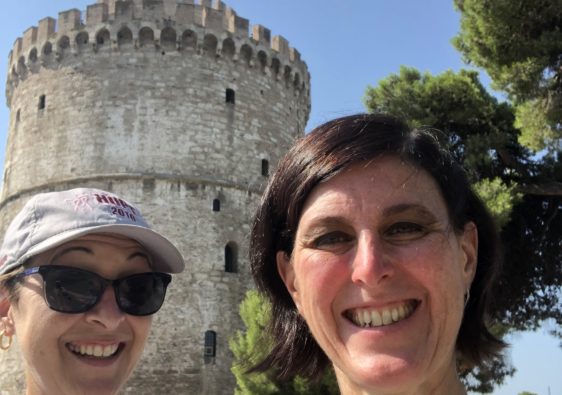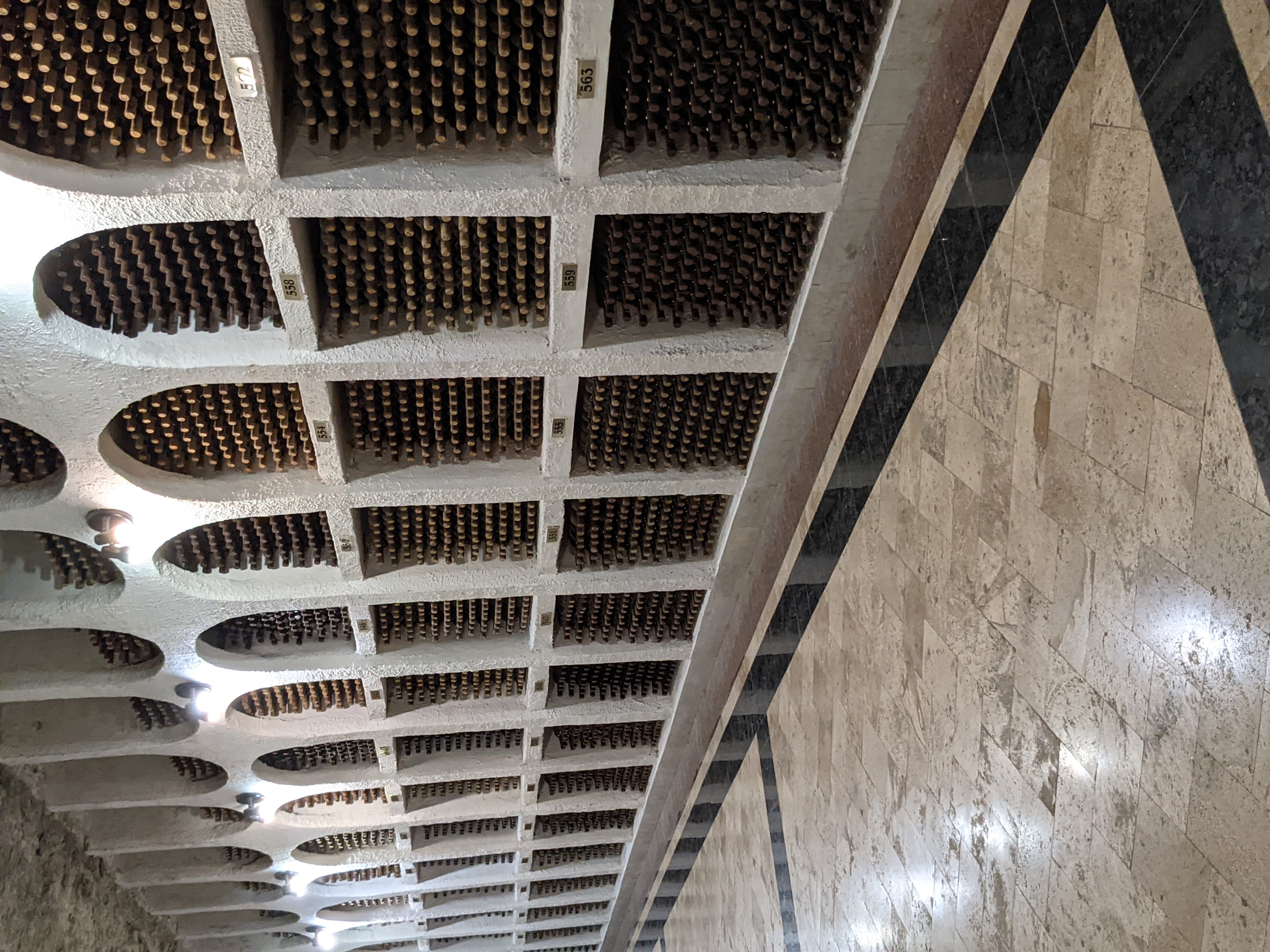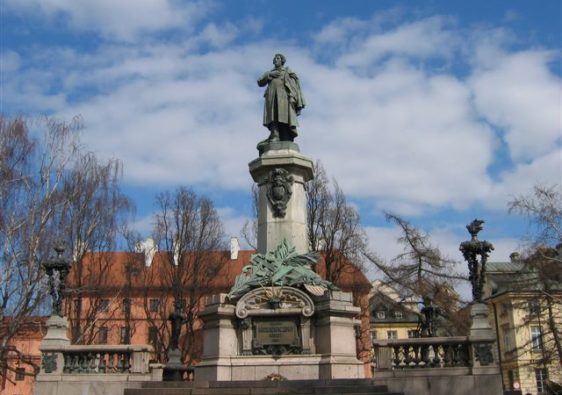We took an 8-ish hour drive from Skopje, North Macedonia to Sofia, Bulgaria, which included two stops: quaint Osogovo Monastery in the North Macedonian hills, and magnificent Rila Monastery about 2 hours out of Sofia. Our personable MyDayTrips.com driver Ivo dropped us off at our hotel. And so our Sofia adventure began!
Sofia was one of our “wish we had more time” cities. But because we aren’t full-time travel bloggers, if the choice is between “only 24 hours” and “don’t go,” we will choose the 24 hours every time. And how glad we were that we made it to Sofia, because this city was sophisticated, scenic, and strollable.
We were amazed by the contrasts of ancient and modern here. Sofia has been established since neolithic times, inhabited by groups like the primarily Balkan Thracians, as well as the Serdi, a celtic tribe that Sofia’s name comes from. There is also evidence of Greek activity in Sofia, but the Romans left an indelible impression. More on that in a bit…
Evening Walk – Day 1 Sofia
We did not arrive in Sofia until about 5pm. We settled in to our perfect hotel room (Hyatt Regency Sofia, Vasil Levski Square, bul. “Vasil Levski”, 1504 Sofia Center, Sofia,–booked on points), freshened up, then struck out on the town while it was still light out.
First stop was mere steps outside the Hyatt–the majestic St. Alexander Nevsky Cathedral (pl. “Sveti Aleksandar Nevski”, 1000 Sofia Center, Sofia). It was just outside the ‘yellow brick road [just try not to sing that phrase!] in that small area of town. The yellow bricks signified the first roads that were paved in the capital. The bricks were part of an ambitious plan in the early 1900’s by the then-mayor of the city Martin Todorov to modernize the city and make the central streets look unique.
We then strolled a few blocks and encountered the Church of St. Nicholas the Miracle-Maker (bul. “Tsar Osvoboditel” 3, 1000 Sofia Center, Sofia), a smaller, golden-domed church that could have come from a storybook. After the adjacent Pushkin Park, we headed down Georg Rakovsky street passing a few theaters, parks and nearby government buildings. Hanging a right down Patriarch Evtimiy, we rounded the top of the long Palace of Culture Park, then we finally made it to Vitosha Boulevard.
Vitosha Boulevard was block after block of pedestrian-only streets shaded by trees, and lined with cafes and shops. The street was pleasantly full of people, but not overly crowded. Sofia felt open, old and comfortable and lived in, like a university town. The biggest challenge was to pick one of the cafes when there were so many that looked amazing.
We found the charming BG Wine Restaurant about a block off Vitosha, mercifully. The old movie decor theme with shelves of wine on each wall were casual, and the place was not busy yet at about 7:30pm.
Strolled back down pedestrian Vitosha Street at about 9:00 pm and found my favorite, Lidl. Stocked up on waters and snacks, then hit a local Starbucks as it was closing for souvenir mugs, passed more parks and the National Art Gallery (i, ploshtad “Knyaz Aleksandar I” 1, 1000 Sofia Center, Sofia, Bulgaria), with its whimsical statues on the lawn, then made our way back to the hotel by 9:30.
Day 2 Sofia –
Sofia Synagogue – When our driver dropped us off in Sofia, he pointed out the Cathedral, Mosque, and Synagogue all grouped in the same block in the heart of Sofia – a fact that he was very proud of; proud of Sophia’s openness and acceptance. We had seen numerous Monasteries and cathedrals already, so decided to see the synagogue instead of the Cathedral. It was locked down tight and it definitely didn’t seem like it got many visitors, but we asked to see it, and were allowed to enter after paying an entrance fee. It was beautiful, but seemed to have a pragmatic tone to it. More of a theater or community center feel versus some of the very ornate churches we’d been to.
Hitting the The Serdika Metro station at 1000 Sofia Center made us feel like we were wandering through a museum rather than waiting for the next metro train. The Serdika ruins had been found when Sofia was excavating to build the subway. The subway continued to be built, but the ruins were also showcased. There were signs and walkways through the old ruins, and you could spend time walking through them, or you could hurry on your way to the subway. It seemed, to me, an elegant way of balancing both the need for progress and the need to preserve the past. The ruins themselves were extensive – it was essentially a whole city with homes, streets, baths, etc still existing within and under modern Sofia. f you’re European, maybe you are accustomed to ancient ‘stuff’ in your modern cities, but we Americans are still gobsmacked by it. The settlement of Serdika was discovered while this metro station was being built right through it in the 2010’s.
Photo by Tauni Crefeld Photo by Michele Crefeld
After figuring out our metro ticket situation, we rode the M1/M4 line from Serdika station 4 stops to metro station G.M. Dimitrov, 1756 Studentski Kompleks, then walked about 2 blocks into basically an industrial park in search of the Museum of Socialist Art. We found office buildings, an official looking government building (we think Ministry of Culture–so we knew we were close!) but no museum. We even hiked down a side street towards the Google Maps dot where the museum was supposed to be, but we ended up at an overgrown dead end fence. We toyed with the idea of finding a hole in the fence and moving closer towards the “dot” in GMaps, but opted to double back and talk to the friendly guard in the booth outside the government complex. He pointed with his cigarette to the driveway alongside the government building inside the gates to a foliage covered fence blocking whatever was inside. With some trepidation, we advanced and we made out a mosaic star sculpture beyond the fence. We thought it was a beacon, but we later learned it was the symbol for the socialist party in Bulgaria.
We entered small museum complex and were directed to the ‘Video room” first (after paying our 6 lev pp, of course). This “Video Room” was an overstatement–really just a small tv screen and a few chairs (lol). We spent about 10 minutes viewing the black and white propaganda videos (which were fascinating, despite being entirely in Bulgarian).
Then we proceeded to the sculpture garden, which was filled with busts and statues of former communist leaders, from Che Guevara to Stalin and Lenin.
The whole museum, from the difficulty of finding it, to the scowling guards, had a soviet-era feel, which only made the Soviet-era propaganda films, and the gallery of Soviet art feel more oppressive. Having grown up in the cold war era it still felt sinister.
Photo by Michele Crefeld
“In a third-class carriage,” relief by Ivan Funev 1935. Photo is marked with CC BY-SA 4.0: “File:20140615 Museum of socialist art (Sofia) 08.jpg” by Mark Ahsmann.
“File:20140615 Museum of socialist art (Sofia) 42.jpg” by Mark Ahsmann is marked with CC BY-SA 4.0.
“Museum of Socialist Art” by D-Stanley is marked with
“Sofia Socialist Art Museum” by BlackDaffodil
is marked with CC BY-NC 2.0.
(I think I’m obsessed with this museum)



